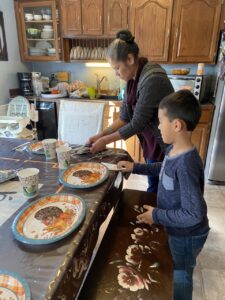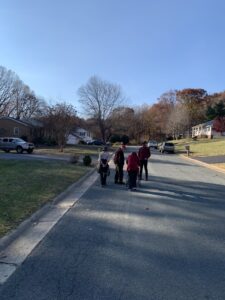“… Let them therefore praise the Lord, because He is good, and His mercies endure forever. Yea, let them that have been redeemed of the Lord, show how He hath delivered them from the hand of the oppressor. When they wandered forth into the desert-wilderness, out of the way, and found no city to dwell in, both hungry and thirsty, their soul was overwhelmed in them. Let them confess before the Lord His loving kindness, and His wonderful works before the sons of men!” –William Bradford, Of Plymouth Plantation 1620
*****
With minimal media attention, today marks the 400th anniversary of the now-famous First Thanksgiving held by the Pilgrims and their 90-some Wampanoag guests at Plymouth Plantation in Massachusetts, held in late 1621.
The Pilgrims, numbering 102, were English people seeking to leave England for a new place with new freedoms and opportunities. One group of them, called Saints, were Christians who did not agree with the formal ways of the official Church of England and sought a place to practice their faith free of government edicts. (Many are surprised to learn, England was so repressive at that time, it was illegal to hold religious services or a Bible study in a private home.) The other group, called Strangers, had other motivations such as seeking freedom and a new life in a new place. Along with 30-some crew members and captains, they all boarded the Mayflower and sailed from Plymouth, England on September 16, 1620. Their desired destination was “Northern Virginia” (which is now actually New York State).
(For historical context, this was thirteen years after the English established their colony at Jamestown, Virginia in 1607.)
After a harrowing 65 days at sea, and having been driven far off course by wind and waves, the Mayflower and its passengers landed at Cape Cod in what is now Massachusetts. To make things worse, they landed in November–not a pleasant time to start a new life in a new land.
Amazingly, today about 30 million people trace their ancestry to those 102 passengers and thirty-some crew members.
In that harsh first winter, from the ravages of hunger and disease, over half of the 102 passengers perished.

However, by fall of 1621, after one year in the New World, they held a celebration to thank God for their success and survival to date. Details about that First Thanksgiving are scant, because only two written records report it. We do not know the exact date, but because the Pilgrims celebrated a good harvest, it was probably held between September and November. We do not know the exact menu, other than it included “fowl” and “five deer.” We do not even know if the Pilgrims made it an annual event or just celebrated it once, because only the 1621 gathering is recorded.
Pilgrim Edward Winslow in December 1621 wrote a letter to a friend in England. That letter contains almost all we know about that first Thanksgiving. Here is an excerpt:
Our harvest being gotten in, our governor sent four men on fowling, that so we might after have a special manner rejoice together after we had gathered the fruit of our labors; they four in one day killed as much fowl, as with a little help beside, served the company almost a week, at which time amongst other recreations, we exercised our arms, many of the Indians coming amongst us, and among the rest their greatest King Massasoit, with some ninety men, whom for three days we entertained and feasted, and they went out and killed five deer, which they brought to the plantation and bestowed on our governor, and upon the captain, and others. And although it be not always so plentiful as it was at this time with us, yet by the goodness of God, we are so far from want that we often wish you partakers of our plenty.
Despite the scant information we know about it…or perhaps because of its scantiness…that First Thanksgiving has become not only the stuff of legend, but many claim it has become our American “Creation Myth.” Unlike many Christian holidays that are global such as Christmas and Easter, Thanksgiving is uniquely American. Some call it “the most-American, American holiday.”
By the time of the United States’ official founding in 1776, that First Thanksgiving was already at its 155th anniversary. In the early days of our Republic, Thanksgiving was mainly a New England phenomenon, and different states celebrated it on different dates (if they even acknowledged the holiday at all.)
It was in 1863, in the midst of the Civil War and exactly three months after the Battle of Gettysburg, that President Lincoln issued his Thanksgiving Declaration. In it, he mandated Thanksgiving be celebrated as a national holiday, on the last Thursday of November.
*****

Residents of Southwest Virginia who rose early today were treated to a spectacular sunrise around 7:00. As noon approached, many homes had a number of cars parked out front as friends and family gathered.
Many folks, with family or friends in the region, enjoyed Thanksgiving lunch with one set of people then drove to see other friends or the other side of the family for dinner. One resident of Salem observed an unusually high number of households flying a US flag today.
Hitting a high of 66 today with full sun, the afternoon was an inviting time to take a walk to work off some of the extra carbohydrates.

All in all, at least in Southwest Virginia, it was a beautiful day for celebrating the 400th anniversary of Thanksgiving.
Happy 400th Thanksgiving!
–Scott Dreyer
Sources/Go Deeper:
